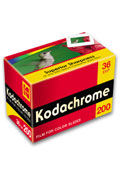|
Photographic film: How it works

Photographic film is essentially a thin plastic base coated with an emulsion.
The emulsion is composed of gelatin within which tiny particles of
light-sensitive salts have been suspended. The salts used are usually silver
HALIDES, such as silver iodide. The stored reaction to light (after the film has
been exposed in the camera) is called the latent image and can be seen only
after the film has been processed, or developed (see FILM PROCESSING). A glass
base may be coated with an emulsion for a special scientific or research
purpose.
An antihalation backing is applied to the underside of the base to prevent a
halo effect or flare around bright objects when light bounces back and passes
through the film a second time. Overcoats are applied to the film to minimize
abrasion when the film moves through the camera and when it is processed.
Because of the nature of the silver halides in the emulsion, all light-sensitive
photographic emulsions are sensitive to the violet and blue end of the visible
spectrum. By adding different types of sensitizing dyes to the emulsion, film
can be made to react to the entire spectrum or to limited portions of it. This
response to different wavelengths of light is called color sensitivity. Film
that is sensitive to light over the entire visible spectrum is called
panchromatic and is the type used for most general photography.
By varying the amount and type of sensitizing dye used, the film's sensitivity
to light intensity, which is called emulsion speed, may be adjusted. The speed
figures were devised to indicate the minimum exposure necessary to produce a
specified degree of blackening of the film. The American Standards Association (ASA)
is one organization that has developed a system for measuring this speed. In
this system, known as the ASA Exposure Index or simply ASA, the higher the
numerical rating, the faster the film's speed. Thus, a film rated at ASA 100 is
twice as fast as and will require only half the exposure of a film rated at ASA
50. For the most part, the faster a film is, the more grainy it appears.
In a film negative, those areas containing the lightest objects (highlights)
will have the greatest amount of density after processing, while the darkest
objects (shadows) will have relatively less. Contrast is the intermediate range
of tones between the very light and very dark elements in the original
photograph. A high-contrast film will record only the highlights and shadows, or
just white and black, whereas a medium- or low-contrast film will also record
the intermediate tones. Black-and-white negative film generally has only one
emulsion layer, which is sensitive more or less equally to all the colors in the
visible spectrum.
After processing, the highlights appear as
solid black on the negative, the shadows as clear, and the middle tones as gray.
White light can be created by superimposing, or adding together, equal amounts
of red, green and blue light, the additive primary COLORS. Any two of these
primary colors, when combined, form yet another color, the complement, or
opposite, of the third primary. For example, green and blue produce the color
cyan, which is the opposite of red; red and blue produce magenta, the opposite
of green; and green and red produce yellow, the opposite of blue.
The colors cyan, magenta, and blue are
referred to as the subtractive primaries because each represents the remaining
color after one primary color has been subtracted from white light. Color
negative film emulsion is composed of three dye layers, each one sensitive to a
separate component of light--red, green, or blue. During processing, these three
layers form, respectively, the dye colors cyan, blue, and magenta. Thus, red
will appear as cyan, green as magenta, and blue as yellow on the negative.
|